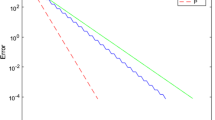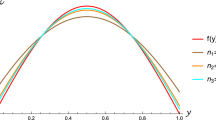Abstract
In this paper, we employ iteration on operator version of the famous Young inequality and obtain more arithmetic-geometric mean inequalities and the reverse versions for positive operators. Concretely, we obtain refined Young inequalities with the Kantorovich constant, the reverse ratio type and difference type inequalities for arithmetic-geometric operator mean under different conditions.
Similar content being viewed by others
1 Introduction
Throughout this paper, A, B are both positive operators on a Hilbert space H, and \(\mathcal{B}_{h}(H)\) is the semi-space of all bounded linear self-adjoint operators on H. In addition, notation \(\mathcal {B}^{+}(H)\) is written as the set of all positive operators in \(\mathcal{B}_{h}(H)\). Besides, we may assume that A and B are invertible without loss of generality,
When \(\mu=1/2\) we write \(A\nabla B\) and \(A\sharp B\) for brevity, respectively; see Kubo and Ando [1]. The Kantorovich constant is defined by \(K(t,2)=\frac{(t+1)^{2}}{4t}\) for \(t>0\), while the Specht ratio [2] is denoted by
and has the following properties:
-
(i)
\(S(t) = S(\frac{1}{t})\geq1\) for \(t> 0\).
-
(ii)
\(S(t)\) is a monotone increasing function on \((1,+\infty)\).
-
(iii)
\(S(t)\) is a monotone decreasing function on \((0, 1)\).
We start from an improvement of the famous Young inequality as follows.
Theorem ZS
[3]
For a, \(b>0\), we have
for all \(\mu\in[0,1]\), where \(r=\min\{\mu,1-\mu\}\) and \(h=\frac{b}{a}\). It admits an operator extension
for positive operators A and B on a Hilbert space.
Next, we show the reverse arithmetic-geometric mean inequality with the Specht ratio for two positive operators.
Theorem T
[4]
For invertible operators A and B with \(0< aI_{H}\leq A,B\leq bI_{H}\), we have
where \(L(1,h)\) is defined by \(L(a,b)=\frac{a-b}{\log a-\log b}(a\neq b); L(a,a)=a\), \(h=\frac{b}{a}\).
These inequalities have recently been improved by Furuichi [5] as follows.
Theorem F
[5]
If \(0< aI_{H}\leq A,B\leq bI_{H}\), then
where \(r=\min\{\mu,1-\mu\}\), \(L(a, b)=\frac{a-b}{\log a-\log b}\), \(h=\frac{b}{ a}\).
Afterwards, Krnić et al. [6] introduced Jensen’s operator and established some bounds for the spectra of Jensen’s operator. The obtained results were then applied to operator means. In such a way, they get refinements and converses of numerous mean inequalities for Hilbert space operators. See [1, 2, 4, 6–10] for more related developments.
See also [11] for another improvement of the reverse weighted arithmetic-geometric operator mean inequalities. Their proof is independent of [5].
Theorem ZF
[11]
If \(0< aA\leq B\leq bA\) with \(0< a<1<b\), then
where \(r=\min\{\mu,1-\mu\}\), \(L(a, b)=\frac{a-b}{\log a-\log b}\).
This paper aims to provide a method to obtain more arithmetic-geometric mean inequalities and the reverse version for positive operators. In Section 2, we introduce the main lemmas. In Section 3, utilizing the refined Young inequality and iteration method, we establish some weighted arithmetic-geometric mean inequality for two positive operators. We also obtain reverse ratio type and difference type inequalities for positive operators by means of iteration under different conditions in Section 4 and Section 5, respectively.
2 Main lemmas
First of all, the main lemmas including operator iteration can be stated as follows.
Lemma 2.1
[6]
If \(A,B\in\mathcal{B}^{+}(H)\), \(0\leq\mu,\nu\leq1\), then
Lemma 2.2
If A and B are positive operators on a Hilbert space, \(0\leq\mu,\nu\leq1\), then
Proof
□
3 Further refinement of the Young inequalities
In this section, we use the scalar ratio type arithmetic-geometric mean inequality to get a series of operator versions.
Lemma 3.1
[3]
If a, \(b>0\) and \(\mu\in[0,1]\), then
where \(r=\min\{\mu,1-\mu\}\) and \(h=\frac{b}{a}\).
Using the method of the proof of Theorem 7 in [3] we can obtain the following theorem.
Theorem 3.2
If A, \(B\geq0\), \(1< h\leq A^{-\frac{1}{2}}BA^{-\frac {1}{2}}\leq h'\) or \(0< h'\leq A^{-\frac{1}{2}}BA^{-\frac{1}{2}}\leq h<1\), then
for all \(\mu\in[0,1]\), where \(r=\min\{\mu,1-\mu\}\).
Proof
For the case of \(1< h\leq A^{-\frac{1}{2}}BA^{-\frac {1}{2}}\leq h'\), by Lemma 3.1 we have
for any \(x>0\). And hence
for a positive operator X such that \(1< hI\leq X\leq h'I\).
Substituting \(A^{-\frac{1}{2}}BA^{-\frac{1}{2}}\) for X in the above inequality we have
It is easy to check that the function \(K(x,2)\) is increasing for \(x>1\), then
Multiplying both sides by \(A^{\frac{1}{2}}\) to inequality (3.2), we obtain the required inequality.
For the case of \(0< h'\leq A^{-\frac{1}{2}}BA^{-\frac{1}{2}}\leq h<1\), since the function \(K(x,2)\) is decreasing for \(0< x<1\) and \(K(\frac {1}{h},2)=K(h,2)\), similarly we obtain inequality (3.1). □
Theorem 3.3
For two operators A, \(B\geq0\) and \(1< h\leq A^{-\frac {1}{2}}BA^{-\frac{1}{2}}\leq h'\) or \(0< h'\leq A^{-\frac {1}{2}}BA^{-\frac {1}{2}}\leq h<1\), we have
for all \(\mu\in[0,1]\), where \(r=\min\{\mu,1-\mu\}\) and \(R=\min\{ 2r,1-2r\}\).
Proof
If \(0\leq\mu\leq\frac{1}{2}\), then \(0\leq2\mu \leq1\).
Here \(1< h\leq A^{-\frac{1}{2}}BA^{-\frac{1}{2}}\leq h'\) ensures that \(1<\sqrt{h}\leq A^{-\frac{1}{2}}(A\sharp B)A^{-\frac{1}{2}}\leq \sqrt {h'}\), and \(0< h'\leq A^{-\frac{1}{2}}BA^{-\frac{1}{2}}\leq h<1\) ensures that \(0<\sqrt{h'}\leq A^{-\frac{1}{2}}(A\sharp B)A^{-\frac {1}{2}}\leq \sqrt{h}<1\), respectively. Substituting B by \(A\sharp B\) and μ by 2μ in (3.1), it follows that
By Lemma 2.1 and \(A\sharp_{2\mu}(A\sharp B)=A\sharp_{\mu}B \), we have
and then
If \(\frac{1}{2}\leq\mu\leq1\), then \(0\leq1-\mu\leq\frac{1}{2}\). By the above inequality we have
Therefore, for \(0\leq\mu\leq1\), we have
This completes the proof. □
Now, applying the same iteration method as in Theorem 3.2 to inequality (3.3), we obtain the following.
Corollary 3.4
Assume the conditions as in Theorem 3.3. Then
for all \(\mu\in[0,1]\), where \(r=\min\{\mu,1-\mu\}\), \(R=\min\{ 2r,1-2r\} \), \(R'=\min\{2R,1-2R\}\), \(h=\frac{M}{m}\), and \([x]\) is the greatest integer less than or equal to x.
Corollary 3.5
[12]
Suppose that two operators A, B and positive real numbers m, \(m'\), M, \(M'\) satisfy either \(0< m'I\leq A\leq mI< MI\leq B\leq M'I\) or \(0< m'I\leq B\leq mI< MI\leq A\leq M'I\).
-
(I)
If \(0\leq\mu\leq\frac{1}{2}\), then
$$\begin{aligned} A\nabla_{\mu}B-(2r-R) (A\nabla B-A\sharp B)-2R(A\nabla _{\frac{1}{4}} B-A\sharp_{\frac{1}{4}} B)\geq K(\sqrt {h},2)^{R'}A\sharp _{\mu}B. \end{aligned}$$ -
(II)
If \(\frac{1}{2}\leq\mu\leq1\), then
$$\begin{aligned} A\nabla_{\mu}B-(2r-R) (A\nabla B-A\sharp B)-2R(A\nabla _{\frac{3}{4}} B-A\sharp_{\frac{3}{4}} B)\geq K(\sqrt {h},2)^{R'}A\sharp _{\mu}B, \end{aligned}$$where \(r=\min\{\mu,1-\mu\}\), \(R=\min\{2r,1-2r\}\), \(R'=\min\{ 2R,1-2R\}\), \(h=\frac{M}{m}\), and \(h'=\frac{M'}{m'}\).
Proof
In the case of (i), \(1< h=\frac{M}{m}\leq A^{-\frac {1}{2}}BA^{-\frac{1}{2}}\leq\frac{M'}{m'}=h'\); In the case of (ii), \(0<\frac{1}{h'}=\frac{m'}{M'}\leq A^{-\frac{1}{2}}BA^{-\frac {1}{2}}\leq \frac{m}{M}=\frac{1}{h}<1\). Then Corollary 3.4 leads to the required inequality. This completes the proof. □
4 Reverse ratio type arithmetic-geometric mean inequalities
In the following, we show a refinement of reverse arithmetic-geometric mean inequality by applying the main lemmas in Section 2.
Theorem 4.1
If \(0< aI \leq A^{-\frac{1}{2}}BA^{-\frac{1}{2}} \leq bI\) with \(a<1<b\), and \(0\leq\mu\leq1\), then
where \(r=\min\{\mu,1-\mu\}\), \(R=\min\{2r,1-2r\}\).
Proof
If \(0\leq\mu\leq\frac{1}{2}\), then \(0\leq2\mu \leq1\). Since \(0< aI \leq A^{-\frac{1}{2}}BA^{-\frac{1}{2}} \leq bI\) ensures that \(\sqrt{a}A\leq A\sharp B\leq\sqrt{b}A\), by substituting B by \(A\sharp B\) and μ by 2μ in (i) of Theorem ZF, it follows that
Lemma 2.2 leads to the following equalities:
Then it follows by Lemma 2.1 that
If \(\frac{1}{2}\leq\mu\leq1\), then \(0\leq1-\mu\leq\frac{1}{2}\). The hypothesis \(0< aI \leq A^{-\frac{1}{2}}BA^{-\frac{1}{2}} \leq bI\) admits \(\frac{1}{\sqrt{b}}B\leq B\sharp A\leq\frac{1}{\sqrt{a}}B \). Then by the inequality (4.1) we have
Notice that \(S(\frac{1}{\sqrt[4]{a}})=S(\sqrt[4]{a})\) and \(S(\frac {1}{\sqrt[4]{b}})=S(\sqrt[4]{b})\), so it follows that
This completes the proof. □
Since \(0< aI_{H}\leq A, B\leq bI_{H}\) with \(a< b\) admits that \(\frac {1}{\sqrt{h}}\leq A^{-\frac{1}{2}}BA^{-\frac{1}{2}} \leq\sqrt{h}\) where \(\frac{1}{\sqrt{h}}<1<\sqrt{h}\), we obtain the counterpart of Theorem 4.1.
Corollary 4.2
If \(0< aI\leq A, B\leq bI\) with \(a< b\) and \(0\leq\mu \leq1\), then
where \(r=\min\{\mu,1-\mu\}\), \(R=\min\{2r,1-2r\}\), and \(h=\frac{b}{a}\).
5 Reverse difference type arithmetic-geometric mean inequalities
In the following theorem we show the corresponding difference type analogs of Theorem 4.1.
Theorem 5.1
If \(0\leq\mu\leq1\) and \(0< aI\leq A^{-\frac {1}{2}}BA^{-\frac{1}{2}}\leq bI\) with \(a<1<b\), then
where \(r=\min\{\mu,1-\mu\}\), \(R=\min\{2r,1-2r\}\).
Proof
(I) If \(0\leq\mu\leq\frac{1}{2}\), then \(0\leq2\mu\leq1\). Since \(0< aI\leq A^{-\frac{1}{2}}BA^{-\frac{1}{2}}\leq bI\) ensures that \(\sqrt {a}A\leq A\sharp B\leq\sqrt{b}A\), substitute B by \(A\sharp B\) and μ by 2μ in (ii) of Theorem ZF, so we obtain
As showed in the proof of Theorem 4.1, the following inequality holds:
since \(a<1<b\) and \(L(\frac{1}{\sqrt[4]{a}},1)=\frac{1}{\sqrt [4]{a}}L(\sqrt[4]{a},1)\).
(II) If \(\frac{1}{2}\leq\mu\leq1\), then \(0\leq1-\mu\leq\frac {1}{2}\). The hypothesis \(0< aI\leq A^{-\frac{1}{2}}BA^{-\frac {1}{2}}\leq bI\) ensures \(\frac{1}{\sqrt{b}}B\leq B\sharp A\leq\frac{1}{\sqrt{a}}B \). Then by the inequality (5.1) and \(S({\frac{1}{\sqrt [4]{a}}})=S(\sqrt [4]{a})\), we have
The proof is done. □
Similarly, we replace the hypothesis \(0< aI \leq A^{-\frac {1}{2}}BA^{-\frac{1}{2}} \leq bI\), where \(a<1<b\) by \(0< aI\leq A, B\leq bI\) with \(a< b\), and we obtain the following.
Corollary 5.2
If \(0< aI\leq A, B\leq bI\) with \(a< b\), and \(0\leq\mu \leq1\), then
where \(r=\min\{\mu,1-\mu\}\), \(R=\min\{2r,1-2r\}\), and \(h=\frac{b}{a}\).
References
Kubo, F, Ando, T: Means of positive operators. Math. Ann. 246(3), 205-224 (1980)
Tominaga, M: Specht’s ratio in the Young inequality. Sci. Math. Jpn. 55(3), 583-588 (2002)
Zuo, HL, Shi, GH, Fujii, M: Refined Young inequalities with Kantorovich constant. J. Math. Inequal. 5(4), 551-556 (2011)
Pečarić, J, Beesack, PR: On Jensen’s inequality for convex functions II. J. Math. Anal. Appl. 118, 125-144 (1986)
Furuichi, S: On refined Young inequalities and reverse inequalities. J. Math. Inequal. 5(1), 21-31 (2011)
Krnić, M, Lovričević, N, Pečarić, J: Jensen’s operator and applications to mean inequalities for operators in Hilbert space. Bull. Malays. Math. Soc. 35(1), 1-14 (2012)
Hirzallah, O, Kittaneh, F, Krnić, M, Lovričević, N, Pečarić, J: Refinements and reverses of means inequalities for Hilbert space operators. Banach J. Math. Anal. 7(2), 15-19 (2013)
Klarič, M, Pečarić, J, Perić, J: On the converse Jensen inequality. Appl. Math. Comput. 218, 6566-6575 (2012)
Krnić, M, Lovričević, N, Pečarić, J: Improved arithmetic-geometric and Heinz means inequalities for Hilbert space operators. Publ. Math. (Debr.) 80, 3-4 (2012)
Specht, W: Zer Theorie der elementaren Mittel. Math. Z. 74, 91-98 (1960)
Zuo, HL, Fujii, M, Fujii, JI, Seo, Y: Upper bound for spectra of Jensen operator and its application to reverse arithmetic-geometric means. Math. Inequal. Appl. 17(2), 641-648 (2014)
Liao, WS, Wu, JL: Improved Young and Heinz inequalities with the Kantorovich constant. J. Math. Inequal. 10(2), 559-570 (2016)
Acknowledgements
We wish to thank the referee for careful reading and valuable comments for the original draft. This research was supported by the National Natural Science Foundation of China (11501176) and the Science and Technology Planning Project of the Education Department of Henan Province (14B110009).
Author information
Authors and Affiliations
Corresponding author
Additional information
Competing interests
The authors declare that they have no competing interests.
Authors’ contributions
All authors contributed equally to the writing of this paper. All authors read and approved the final manuscript.
Rights and permissions
Open Access This article is distributed under the terms of the Creative Commons Attribution 4.0 International License (http://creativecommons.org/licenses/by/4.0/), which permits unrestricted use, distribution, and reproduction in any medium, provided you give appropriate credit to the original author(s) and the source, provide a link to the Creative Commons license, and indicate if changes were made.
About this article
Cite this article
Zhao, X., Li, L. & Zuo, H. Operator iteration on the Young inequality. J Inequal Appl 2016, 302 (2016). https://doi.org/10.1186/s13660-016-1249-z
Received:
Accepted:
Published:
DOI: https://doi.org/10.1186/s13660-016-1249-z




